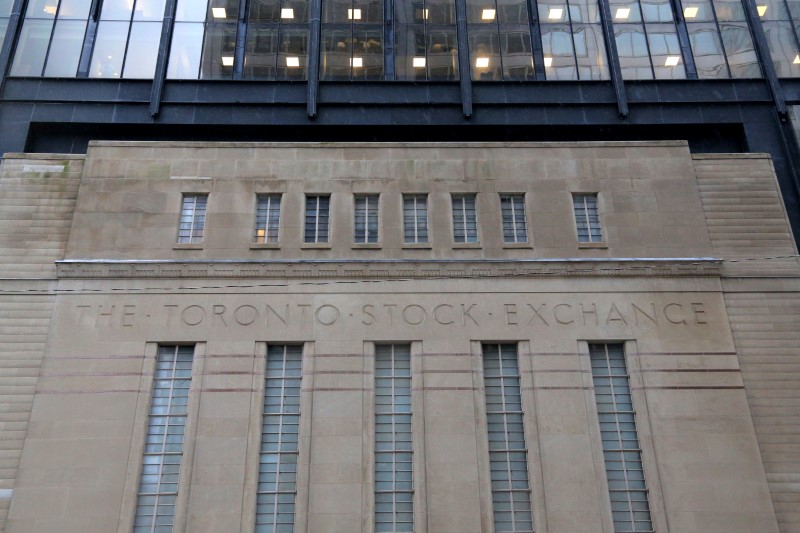Starbucks union plans Red Cup Day strike in 25+ cities - Bloomberg
Investing.com - Canada’s main stock index slipped on Thursday after the average extended its retreat from a recent all-time high in the prior session.
The {{24441|S&P/TSX composite index} was down 24 point or 0.08% at 29,731.98.
On Wednesday, index slipped by 0.2% to end at 29,756.95, marking another leg down from a record closing high logged on Monday. But the average remained on track to post a third-quarter gain of 10.8%, which would be its fifth consecutive quarterly advance.
A drop in the price of gold from its own all-time high dented materials sector shares, including metal mining stocks.
U.S. stocks down
U.S. stocks were trading down on Thursday, as investors warily awaited the release of weekly jobless claims as a guide to future Federal Reserve monetary policy.
The Dow Jones Industrial Average was down 173 points, or 0.38%, the S&P 500 index dropped 34 points, or 0.51%, and the NASDAQ Composite slumped 113 points, or 0.5%.
The main Wall Street indices closed lower Wednesday, falling for a second straight session from record highs, with technology stocks leading the decline amid concerns around over-stretched valuations and uncertainty about the Fed’s next policy moves.
Signs of U.S. economic strength
Sentiment has been hit of late by comments from Fed Chair Jerome Powell, who stated earlier in the week that there is “no risk-free path” for the central bank as it weighs risks from both inflation and a cooling labor market.
These cautious statements about the path ahead for interest rates following last week’s 25-basis point cut in borrowing costs have created a degree of uncertainty of the number of reductions the Fed will announce this year.
With this in mind, investors carefully digested the latest weekly jobless claims data as well as a final reading of second-quarter U.S. gross domestic product, released earlier in the session.
First-time applications for unemployment benefits during the week ended on September 20 came in at 218,000, a decrease of 14,000 from the preceding week.
Meanwhile, U.S. gross domestic product, an indicator of growth in the world’s biggest economy, expanded by 3.8% during the April to June period, according to the third and final estimate from the Commerce Department’s Bureau of Economic Analysis.
A prior estimate had suggested that the U.S. economy grew by 3.3% in the second quarter, after contracting by 0.5% in the opening three months of 2025. The initial estimate showed growth of 3.0%.
Rate projections from the Fed last week suggested that most members were anticipating another half-point worth of cuts at the central bank’s final two meetings of the year in October and December. However, seven of the 19 estimates forecast fewer reductions this year, suggesting the debate could be fierce heading into the next Fed gatherings.
"The implications are obviously hawkish and given how much Fed easing anticipation has contributed to the equity rally of late, stocks will see pressure off the data," analysts at Vital Knowledge said in a note.
All eyes are now on the release of the Fed’s preferred inflation measure, the personal consumption expenditures price index, on Friday.
Government shutdown looms
Markets are also fretting over a looming partial government shutdown as lawmakers remain locked in a funding standoff, with both chambers struggling to agree on a short-term extension.
The Senate last week rejected a Republican-backed stopgap bill that would have kept the government funded until Nov. 21, citing Democratic opposition over the exclusion of healthcare and Medicaid provisions.
A Politico report late Wednesday said that the White House budget office has instructed federal agencies to prepare layoff plans that could trigger mass firings if a government shutdown occurs next week.
Crude falls
Oil prices fell Thursday, sliding from a seven-week high amid uncertainty around the supply-and-demand outlook.
At 06:52 ET, Brent futures dropped 0.3% to $69.11 a barrel, and U.S. West Texas Intermediate crude futures fell 0.4% to $64.76 a barrel.
Both benchmarks gained 2.5% on Wednesday to their highest levels since August 1, driven by a surprise drop in U.S. weekly crude inventories and concerns Ukraine’s attacks on Russia’s energy infrastructure could disrupt supplies.
Gold ticks higher
Gold prices moved higher, with a marginally-weaker U.S. dollar lending support to the yellow metal as investors geared up for the release of more economic data.
The figures could shed more light on the path ahead for U.S. interest rates. Lower borrowing costs can reduce the opportunity cost of holding non-yielding assets such as bullion, burnishing the attractiveness of gold.
Spot gold was last up 0.6% at $3,758.63 an ounce by 06:54 ET, after sliding from Tuesday’s record peak of $3,790.82/oz. U.S. gold futures for December edged up 0.6% to $3,789.00.
